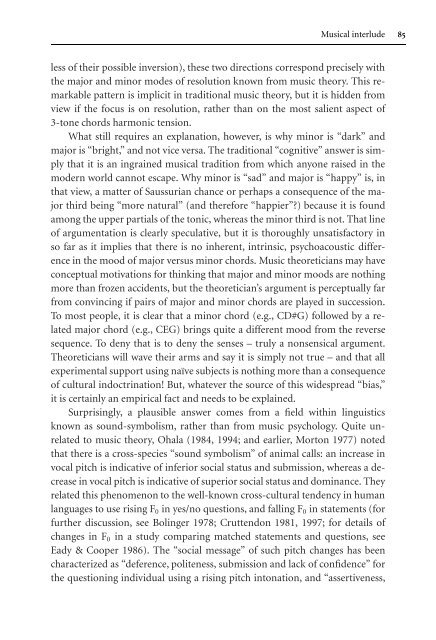Tone of Voice and Mind : The Connections between Intonation ...
Tone of Voice and Mind : The Connections between Intonation ...
Tone of Voice and Mind : The Connections between Intonation ...
You also want an ePaper? Increase the reach of your titles
YUMPU automatically turns print PDFs into web optimized ePapers that Google loves.
Musical interlude 85<br />
less <strong>of</strong> their possible inversion), these two directions correspond precisely with<br />
the major <strong>and</strong> minor modes <strong>of</strong> resolution known from music theory. This remarkable<br />
pattern is implicit in traditional music theory, but it is hidden from<br />
view if the focus is on resolution, rather than on the most salient aspect <strong>of</strong><br />
3-tone chords harmonic tension.<br />
What still requires an explanation, however, is why minor is “dark” <strong>and</strong><br />
major is “bright,” <strong>and</strong> not vice versa. <strong>The</strong> traditional “cognitive” answer is simply<br />
that it is an ingrained musical tradition from which anyone raised in the<br />
modern world cannot escape. Why minor is “sad” <strong>and</strong> major is “happy” is, in<br />
that view, a matter <strong>of</strong> Saussurian chance or perhaps a consequence <strong>of</strong> the major<br />
third being “more natural” (<strong>and</strong> therefore “happier”?) because it is found<br />
among the upper partials <strong>of</strong> the tonic, whereas the minor third is not. That line<br />
<strong>of</strong> argumentation is clearly speculative, but it is thoroughly unsatisfactory in<br />
so far as it implies that there is no inherent, intrinsic, psychoacoustic difference<br />
in the mood <strong>of</strong> major versus minor chords. Music theoreticians may have<br />
conceptual motivations for thinking that major <strong>and</strong> minor moods are nothing<br />
more than frozen accidents, but the theoretician’s argument is perceptually far<br />
from convincing if pairs <strong>of</strong> major <strong>and</strong> minor chords are played in succession.<br />
To most people, it is clear that a minor chord (e.g., CD#G) followed by a related<br />
major chord (e.g., CEG) brings quite a different mood from the reverse<br />
sequence. To deny that is to deny the senses – truly a nonsensical argument.<br />
<strong>The</strong>oreticians will wave their arms <strong>and</strong> say it is simply not true – <strong>and</strong> that all<br />
experimental support using naïve subjects is nothing more than a consequence<br />
<strong>of</strong> cultural indoctrination! But, whatever the source <strong>of</strong> this widespread “bias,”<br />
it is certainly an empirical fact <strong>and</strong> needs to be explained.<br />
Surprisingly, a plausible answer comes from a field within linguistics<br />
known as sound-symbolism, rather than from music psychology. Quite unrelated<br />
to music theory, Ohala (1984, 1994; <strong>and</strong> earlier, Morton 1977) noted<br />
that there is a cross-species “sound symbolism” <strong>of</strong> animal calls: an increase in<br />
vocal pitch is indicative <strong>of</strong> inferior social status <strong>and</strong> submission, whereas a decrease<br />
in vocal pitch is indicative <strong>of</strong> superior social status <strong>and</strong> dominance. <strong>The</strong>y<br />
related this phenomenon to the well-known cross-cultural tendency in human<br />
languages to use rising F0 in yes/no questions, <strong>and</strong> falling F0 in statements (for<br />
further discussion, see Bolinger 1978; Cruttendon 1981, 1997; for details <strong>of</strong><br />
changes in F0 in a study comparing matched statements <strong>and</strong> questions, see<br />
Eady & Cooper 1986). <strong>The</strong> “social message” <strong>of</strong> such pitch changes has been<br />
characterized as “deference, politeness, submission <strong>and</strong> lack <strong>of</strong> confidence” for<br />
the questioning individual using a rising pitch intonation, <strong>and</strong> “assertiveness,


